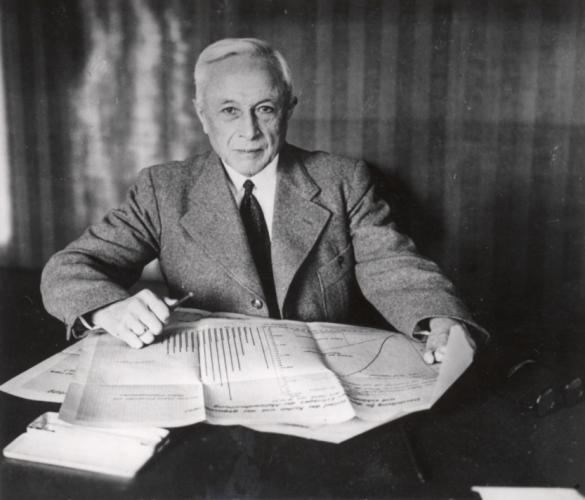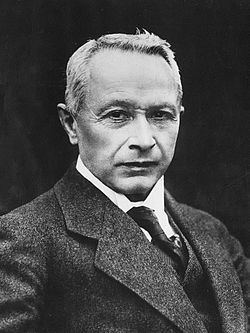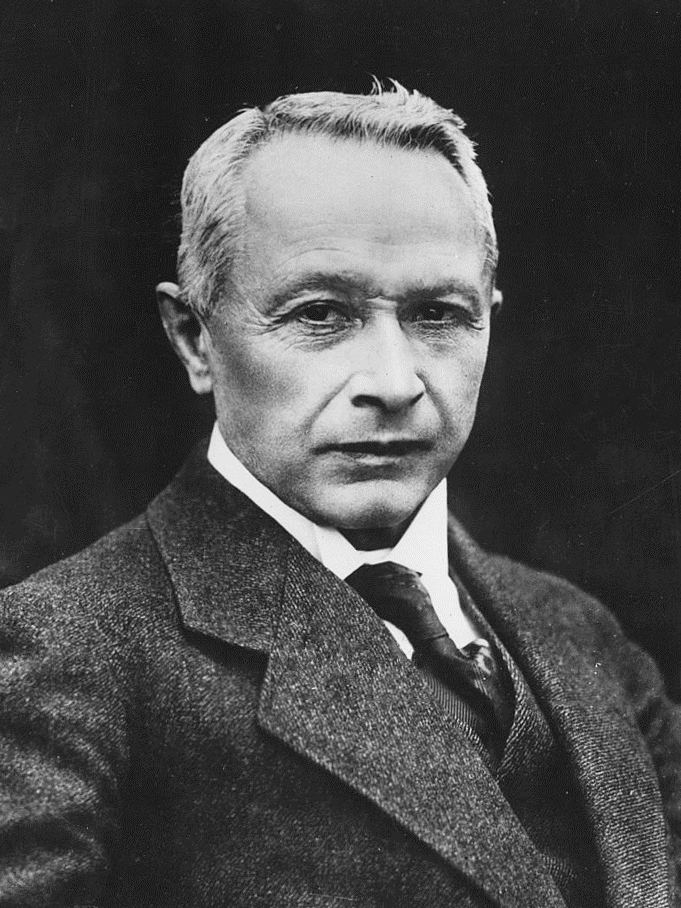Nationality German Role Engineer | Name Hugo Junkers | |
 | ||
Education Technical University of Berlin | ||
Hugo Junkers and the invention of Air Transport Episode 2 – Ostrich Aviation Engineers
Hugo Junkers (3 February 1859 – 3 February 1935) was a German aircraft engineer and aircraft designer. As such, he is generally credited with pioneering the design of all-metal airplanes and flying wings. As founder of what would become the Junkers Flugzeug- und Motorenwerke AG following the First World War's armistice, he was one of the mainstays of the German aircraft industry in the years between World War I and World War II. In particular, his multi-engined all-metal passenger- and freight planes helped establish airlines in Germany, as well as all over the world. Although his name is also linked to some of the most successful German warplanes of the Second World War, Hugo Junkers himself had nothing to do with their development. He was forced out of his own company by the Nazi government in 1934 and died on his 76th birthday, in 1935.
Contents
- Hugo Junkers and the invention of Air Transport Episode 2 Ostrich Aviation Engineers
- Hugo junkers mdr 2005
- Biography
- Aeronautical work
- Political position
- Legacy
- Timeline
- References

As well as aircraft, Junkers also built both diesel and petrol engines and held various thermodynamic and metallurgical patents. He was also one of the main sponsors of the Bauhaus movement and facilitated the move of the Bauhaus from Weimar to Dessau (where his factory was situated) in 1925.

Amongst the highlights of his career were the Junkers J 1 of 1915, the world's first practical all-metal aircraft, incorporating a cantilever wing design with virtually no external bracing, the Junkers F 13 of 1919 (the world's first all-metal passenger aircraft), the Junkers W 33 (which made the first successful heavier-than-air east-to-west crossing of the Atlantic Ocean), the Junkers G.38 "flying wing", and the Junkers Ju 52, affectionately nicknamed "Tante Ju", one of the most famous airliners of the 1930s.

Hugo junkers mdr 2005
Biography

Junkers was born in Rheydt in the Prussian Rhine Province, the son of a well-off industrialist. After taking his Abitur exams in 1878, he attended the Royal Polytechnic University in Charlottenburg and the Royal Technical University in Aachen, where he completed his engineering studies in 1883.

At first, he returned to Rheydt to work in his father's company, but soon attended further lectures on electromagnetism and thermodynamics held by Adolf Slaby in Charlottenburg. Slaby placed him with the Continental-Gasgesellschaft in Dessau, where he worked on the development of the first opposed-piston engine. In order to measure heating value, Junkers patented a calorimeter and founded a manufacturing company in 1892. Junkers personally introduced the calorimeter at the 1893 World's Columbian Exposition in Chicago, where it was awarded a gold medal. The next year, he patented a gas-fired bath boiler, which he refined as a tankless heater. In 1895, he founded Junkers & Co. to utilize his inventions.
From 1897, he was offered a professorship of mechanical engineering at Aachen, where he lectured until 1912. Working as an engineer at the same time, Junkers taking substantial gains of Junkers & Co. devised, patented, and exploited calorimeters, domestic appliances (gas stoves), pressure regulators, gas oil engines, fan heaters, and other inventions.
Aeronautical work
Junkers' aeronautical work began in earnest only at the age of fifty, when he worked with engineer Hans Reissner in Aachen. Reissner had developed an all-metal aircraft, on which work first started in 1909 at the Brand Heath, equipped with corrugated iron wings built by Junkers & Co. in Dessau. The iron wings were patented one year later. Junkers had a wind tunnel built and invented a hydraulic brake.
He had far-sighted ideas of metal aeroplanes and flying wings, but the necessities of the war held him back. During World War I, the government forced him to focus on aircraft production. In 1915, he developed the world's first practical all-metal aircraft design, the Junkers J 1 "Blechesel" (Sheetmetal Donkey), which survived on display in Deutsches Museum in Munich until World War II. His firm's first military production design in 1916–17 was the armored-fuselage, two-seat, all-metal sesquiplane known by its IdFlieg designation, the Junkers J.I, considered the best German ground attack aircraft of the war. During this time, the German government's IdFlieg military aviation inspectorate forced him to merge his firm with Anthony Fokker's to form the Junkers-Fokker Aktiengesellschaft on 20 October 1917. The J.I's pattern of an armored fuselage that protected the nose-mounted engine, pilot, and observer in a unitized metal "bathtub" was the possible inspiration for Sergei Ilyushin's later Il-2 Shturmovik (conceivably appropriate as Junkers did have a manufacturing plant in Fili, a suburb of Moscow, in the Soviet Union in the 1920s) with a similar armored fuselage design. By 1918, his firm, with its previously demonstrated preference for monoplane-pattern airframe designs, had created the world's first low-winged, single-seat monoplane fighter aircraft, the Junkers D.I, which also pioneered the use of duralumin throughout an airframe. However, the D.I did not enter production until 1918. He also produced a two-seat monoplane fighter, the Junkers CL.I. Both the postwar Soviet aviation pioneer Andrei Tupolev and the American aviation designer William Bushnell Stout owed much to Hugo Junkers in the designs of their earlier aircraft, which benefited from Junkers' corrugated, light-metal construction technique.
The Junkers F.13 of 1919 was the first of several successful civil aircraft designs produced by Junkers Flugzeugwerke: later designs include the Junkers Ju 52/3m from 1932. Through a variety of business initiatives, Junkers was also active in founding and developing airlines around the globe initially aiming to sell them its aircraft. Airlines where Junkers played a pivotal role in early phases of their development include Deutsche Luft Hansa and Lloyd Aéreo Boliviano. However, several business ventures failed from wider economic or political problems that hamstrung sound engineering plans. But Junkers always had more ideas: the massive four-engined G.38, nicknamed "Der Grosse Dessauer", delivered to Luft Hansa, made no commercial trips for many months as he repeatedly recalled it to the factory for improvements.
Political position
Junkers was a socialist and a pacifist. For these reasons, he had several occasions to cross swords with German leadership. In 1917, the government forced him into partnership with Anthony Fokker to ensure wartime production targets would be met.
During the 1920s in Germany and among Junkers' employees, a wide spectrum of political views was present. About every aspect of the business and of its environment, there were differing opinions. For members of all the many groups represented in Junkers, aviation offered hope for national renewal. Their varied views led to lively internal corporate politics. In 1926, unable to make government loan repayments after a failed venture to build planes for the USSR, he lost control of most of his businesses. In 1931, he appointed Adolf Dethmann, a communist activist, as Managing Director of what remained of his business.
Upon the 1933 Machtergreifung, the new Nazi government interfered, and the new Reichskommissar of Aviation, Hermann Göring, (who allegedly had unsuccessfully applied as a test pilot in the early 1920s) aimed to make Junkers a tool of German re-armament. The Nazi authorities immediately demanded ownership of Hugo Junkers' patents and the majority of shares of his remaining companies. Under threat of imprisonment, he eventually acquiesced, to little avail; a year later, he was under house arrest and was finally forced to leave Dessau. He died on 3 February 1935 in Gauting near Munich.
Legacy
Hugo Junkers is mainly known in connection with aircraft bearing his name. These include some he reluctantly developed for the German Empire during World War I, later in minor association with Anthony Fokker, as well as civil aircraft designs during the Interwar Period produced by Junkers Flugzeugwerke (Junkers Aircraft Works). Junkers, a pacifist and not on good terms with the Nazis, died in 1935 and was not involved in the development of Junkers military aircraft for the Third Reich's Luftwaffe before or during World War II.
The earliest all-metal post-World War I aircraft designs of both Andrei Tupolev — with his Tupolev ANT-2 two-passenger small aircraft of 1924 — and William Bushnell Stout's initial all-metal design, the Stout ST twin-engine torpedo bomber of 1922, were both based directly on the pioneering work of Junkers, with each engineer (one Soviet, one American) separately developing examples of aircraft like Tupolev's enormous, 63 meter wingspan, eight-engined Maksim Gorki — the largest aircraft built anywhere in the world in the early 1930s — and Stout's popular Ford Trimotor airliner.
